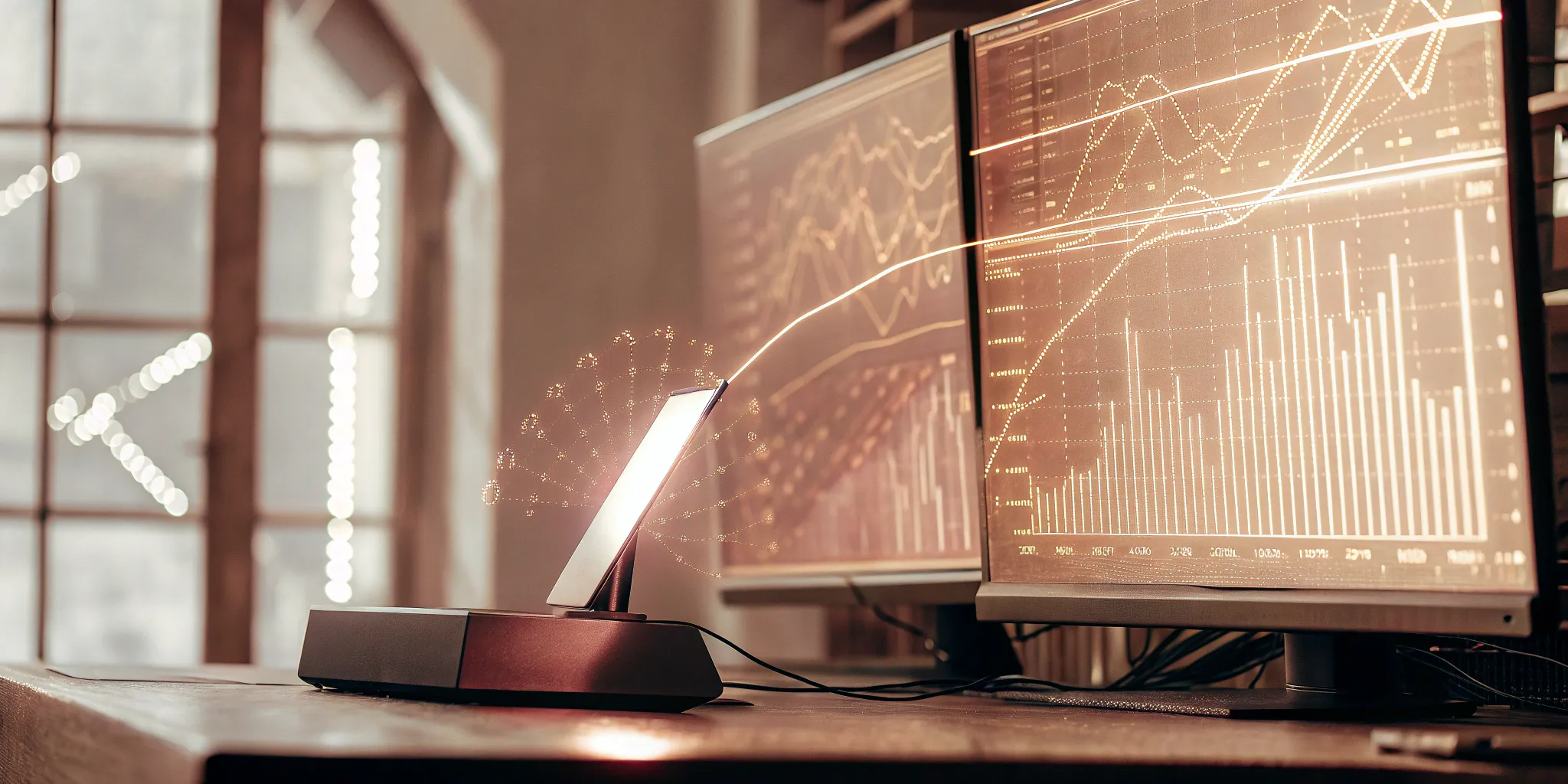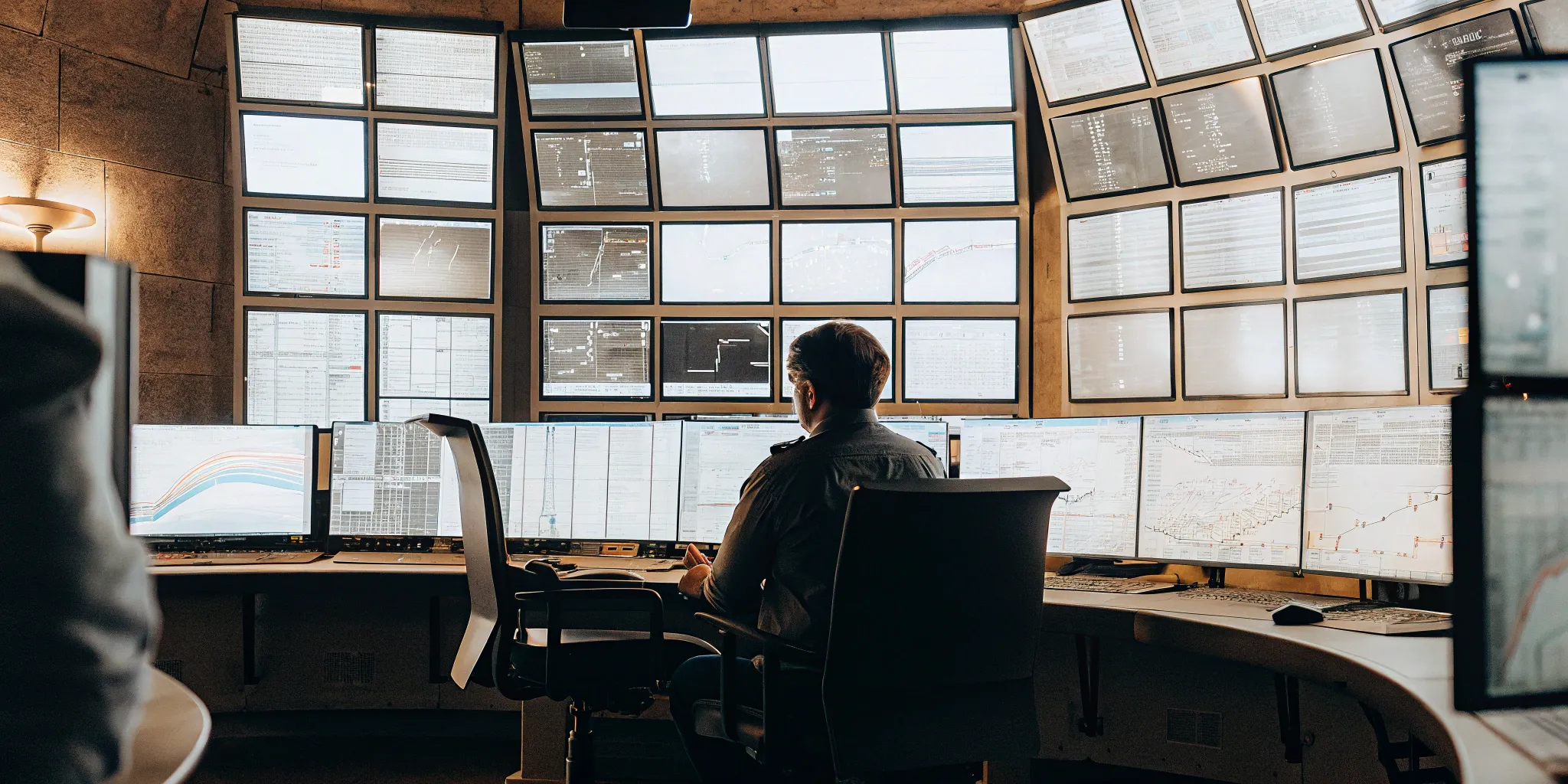Unlocking the potential of automated trading starts with understanding the power of AI. AI trading bots are transforming how investors approach the market, offering speed, efficiency, and data-driven insights that were once exclusive to institutional players. But finding the best AI trading bot requires more than just picking the shiniest new tool. This guide provides a practical, in-depth look at AI trading bots, exploring their core components, essential features, and the critical role of machine learning in their success. We’ll examine the top AI trading bots on the market, including FN Capital’s FAST AI, and provide actionable steps for evaluating their performance, managing risk, and optimizing your chosen bot for maximum effectiveness. Whether you’re a seasoned trader or just beginning your journey, this guide will equip you with the knowledge to navigate the world of AI trading bots and make informed decisions that align with your investment goals.
Key Takeaways
- AI can automate and potentially improve your trading: Bots offer speed and efficiency, but they require careful selection and ongoing monitoring. Don’t expect a hands-off approach to generate guaranteed profits.
- Focus on essential bot features: Prioritize data analysis capabilities, customizable strategies, robust risk management, and a user-friendly interface. Understand the bot’s algorithm and ensure it aligns with your trading style.
- Regularly evaluate and optimize your bot’s performance: Track key metrics, monitor performance in various market conditions, and adapt your strategies as needed. Balance automation with human oversight and stay informed about relevant regulations.
What are AI Trading Bots?
AI trading bots are software programs designed to automate trading strategies. They analyze market data, execute trades, and manage your portfolio, often with minimal human intervention. Think of them as tireless digital assistants dedicated to optimizing your investment returns. They can execute trades faster and more efficiently than a human, reacting to market changes in milliseconds. This speed and precision can be particularly advantageous in volatile markets. For example, FN Capital’s FAST AI algorithm executes thousands of trades per month, focusing on EUR/USD for optimal liquidity.
Definition and Key Components
AI trading bots use vast amounts of data, including market prices, news sentiment, and even social media trends, to identify potentially profitable trading opportunities. They use technical analysis, fundamental analysis, or a combination of both to make informed decisions. These bots automate the entire trading process, from collecting and analyzing data to placing and managing orders. This automation eliminates delays, allowing for swift responses to market fluctuations. AI trading bots also excel at risk management, automatically adjusting position sizes and stop-loss orders to protect your capital. FN Capital uses DART (Dynamic Algorithmic Risk Tool) for real-time risk management, adapting to changing market conditions. User feedback also plays a crucial role in refining performance, allowing for customization based on individual trading goals.
How Machine Learning Powers Trading Bots
Machine learning is the engine that drives AI trading bots. It allows these bots to learn from past data, adapt to changing market conditions, and continuously improve their trading strategies. Through feedback loops, the bot analyzes the outcomes of its trades, identifies patterns, and refines its algorithms to enhance future performance. This iterative process of learning and adaptation is what sets AI trading bots apart from traditional rule-based systems. By incorporating backtesting techniques and performance metrics analysis, developers can fine-tune the bot’s algorithms and optimize its trading strategies for maximum profitability and risk management. FX Blue provides verified performance data, showcasing a proven track record over time. This data-driven approach allows the bot to evolve and become more effective over time, maximizing its potential for generating returns.
Top AI Trading Bots
Here’s a look at some of the top AI trading bots available, including FN Capital’s FAST AI. The best bot for you will depend on your specific needs and trading style.
FN Capital’s FAST AI
FN Capital’s proprietary FAST AI algorithm executes thousands of trades per month, focusing on EUR/USD for optimal liquidity. Unlike retail trading strategies or manual trades, FAST AI removes human bias. Its Dynamic Algorithmic Risk Tool (DART) provides real-time risk management, continuously optimizing positions and exposure. Clients can monitor daily profit and loss in real time while FAST AI executes trades autonomously. A 100-day money-back guarantee lets you test the AI risk-free. User feedback is crucial for refining performance.
Cryptohopper
Cryptohopper is widely considered one of the best overall trading bots, especially for beginners. Its user-friendly interface and educational resources can help new traders learn the ropes. It offers a variety of features, including backtesting, simulated trading, and a marketplace where you can buy and sell trading strategies. It’s considered the best overall bot for beginners.
TradeSanta
TradeSanta is known for its beginner-friendly approach. Its simple setup allows users to quickly engage in both long and short trading strategies, with 24/7 trading capabilities. This makes it an attractive option for those looking for an easy entry point into automated trading.
3Commas
3Commas offers a comprehensive suite of tools for both manual and automated trading. It integrates with multiple exchanges and offers diverse strategies like dollar-cost averaging and grid bots, along with the ability to incorporate trading signals. This makes it a versatile platform for traders of all experience levels. It’s known for its diverse strategies and exchange integrations.
Photon
Photon is recognized as one of the fastest trading platforms on the Solana blockchain. It offers real-time data and one-click trading, along with customizable settings. This makes it a powerful tool for traders looking for speed and efficiency. It’s considered one of the fastest platforms on Solana.
Trojan
Trojan operates through Telegram, simplifying access for many traders. It supports various trading strategies, including dollar-cost averaging and limit orders, and focuses on decentralized exchanges within the Solana ecosystem. This bot is a solid choice for traders interested in decentralized finance (DeFi). It’s known for its ease of use through Telegram.
Essential Features of Effective AI Trading Bots
Looking for an AI trading bot? Here’s what to look for. These key features are essential for any effective automated trading system.
Analyze Data
Effective AI trading bots should excel at analyzing vast amounts of market data. They should ingest and interpret both traditional market data and alternative data sources like news sentiment, social media trends, and even public filings. This comprehensive approach allows the bot to identify opportunities and make informed trading decisions based on a holistic view of the market. AI-driven technical analysis further enhances this capability, providing automated insights that would be time-consuming for a human trader to replicate. Look for bots that can quickly process and interpret this data, converting it into actionable trading signals. TrendSpider, for example, is known for its AI-powered pattern recognition.
Customize Trading Strategies
The ideal AI trading bot offers flexibility. Your bot should allow you to customize trading strategies based on your risk tolerance, investment goals, and preferred assets. This might include setting specific parameters for entries and exits, defining risk management rules, or even incorporating your own proprietary indicators. Platforms like Trade Ideas are known for their strength in algorithmic trading and customizable bot functionality.
Manage Risk
Robust risk management is paramount in automated trading. A good AI trading bot should include features like automated stop-loss orders, position sizing controls, and real-time risk assessments. It’s also important to consider how the bot adapts to changing market conditions. Look for features like dynamic risk adjustments that respond to market volatility. User feedback is also crucial in assessing a bot’s risk management capabilities, so check out reviews and testimonials. Corbanware discusses the importance of user feedback in bot development.
Support Multiple Assets
Diversification is a key element of a sound investment strategy. Your AI trading bot should ideally support a range of assets, allowing you to trade across different markets and asset classes. Whether you’re interested in stocks, cryptocurrencies, forex, or other instruments, ensure the bot can handle your preferred asset mix. Some AI trading algorithms are even capable of full chart pattern recognition across multiple asset classes, as mentioned in reviews of Stock Trading AI.
Use a User-Friendly Interface
Even with sophisticated technology, an effective AI trading bot should be easy to use. A clean, intuitive interface is essential for setting up, monitoring, and adjusting your trading strategies. Look for platforms with clear dashboards, customizable alerts, and easy-to-understand reporting tools. User reviews often highlight the usability of a platform, so look for feedback on the interface. StockChartPro, for instance, is praised for its user-friendly design.
Ensure Strong Security
Security is non-negotiable when dealing with financial technology. Choose an AI trading bot that prioritizes the security of your funds and personal information. Look for features like two-factor authentication, encryption, and secure data storage. The platform should also comply with relevant regulations and industry best practices. AI can play a role in enhancing platform security by identifying unusual trading behaviors, as discussed in this Fintatech guide.
How to Evaluate AI Trading Bot Performance
Evaluating an AI trading bot’s performance requires a deeper look than just checking profits. It involves understanding key metrics, market conditions, and the algorithms driving the bot. A thorough evaluation helps you choose a bot that matches your risk tolerance and goals.
Key Metrics: ROI, Win Rate, and Drawdown
Start with the bot’s return on investment (ROI), which shows the overall profitability of its trading. But ROI alone isn’t enough. The win rate, or percentage of profitable trades, adds another layer of insight. A high win rate with a solid ROI suggests consistent performance. Equally important is the maximum drawdown, the largest peak-to-trough decline in a specific period. A lower drawdown usually means better risk management and capital preservation. AI trading bots often incorporate user feedback to refine these metrics, so prioritize platforms that value user input. Analyzing metrics in depth is key to understanding a bot’s true potential.
Ensure Consistency Across Market Conditions
Markets shift constantly, so a reliable bot should perform well in different cycles. Review the bot’s past performance data to see how it handled both rising and falling markets. Look for consistent returns and controlled drawdowns across various market scenarios. Real-world user feedback is valuable here, offering insights into a bot’s performance under pressure. While artificial intelligence helps bots adapt to changing markets, consistent performance validation remains essential.
Backtest and Simulate
Backtesting lets you test a bot’s strategy against historical market data, simulating real trading. This helps assess potential performance and find any weaknesses in its algorithm. Choose platforms with robust backtesting and customizable parameters. Some platforms, like TrendSpider, offer advanced AI pattern recognition and backtesting. Simulating different market conditions during backtesting gives you a complete picture of the bot’s potential.
Understand Algorithm Effectiveness
A bot’s effectiveness depends on its algorithm. While the details might be proprietary, understanding the general approach is important. Look for information on the data the algorithm uses, its strategies, and its risk management protocols. Some bots excel at algorithmic trading, while others focus on AI pattern recognition. Knowing the algorithm’s strengths and weaknesses helps you decide if it suits your trading style and goals.
Costs and Value of AI Trading Bots
AI trading bots offer a range of features, from basic trade execution to sophisticated market analysis. Understanding the costs associated with these bots—and weighing them against their potential value—is crucial for making informed decisions.
Subscription Models and Pricing
Most AI trading bots operate on a subscription basis, with fees varying depending on the platform’s features and complexity. Some providers, like Trade Ideas, offer both free and paid subscriptions, with the latter unlocking real-time data and advanced tools. Monthly fees can range from under $100 to several hundred dollars, with higher tiers typically providing access to more bots, alerts, and other resources. For example, some plans start at $107 per month.
Consider Hidden Costs
While the subscription fee is the most obvious cost, it’s important to consider potential hidden expenses. Some platforms may charge extra for premium data feeds, advanced charting tools, or specific integrations. Before committing to a platform, carefully review its pricing structure to understand all potential costs. Also, be wary of unrealistic profit promises and remember that the quality of results depends heavily on the data used and the AI’s interpretation. Thorough research and a realistic assessment of potential returns are essential.
Available Discounts and Promotions
Many AI trading bot providers offer discounts and promotions, especially for annual subscriptions or new users. Look for special offers or coupon codes, like the “LST30” code for Liberated Stock Trader, which offers 30% off monthly or 63% off annual plans. It’s always wise to compare pricing across different platforms and take advantage of available deals.
Assess Long-Term Value
Evaluating the true value of an AI trading bot requires looking beyond the sticker price. Consider the potential long-term benefits, such as automated trading strategies, reduced emotional decision-making, and the possibility of increased profits. A well-chosen bot can streamline your trading process, free up your time, and potentially improve your returns. Remember, the right bot depends on your individual needs, technical skills, and trading goals. Choosing wisely can lead to a valuable long-term investment in your trading success.
Risks and Limitations of AI Trading Bots
While AI trading bots offer exciting possibilities, it’s crucial to understand their limitations and potential downsides. Approaching automated trading with a realistic perspective will help you make informed decisions and manage expectations.
Understand Market Volatility Challenges
Markets are inherently unpredictable. Unexpected news, economic shifts, and even social media trends can trigger sudden price swings. While some AI systems aim to predict these changes, the reality is current technology isn’t foolproof. AI can struggle with “hallucinations,” generating inaccurate or inconsistent information, which can lead to poor trading decisions in volatile conditions. No AI can perfectly anticipate every market movement. For more on the current state of AI trading bots, check out this Reddit discussion.
Balance Automation and Human Oversight
Don’t mistake automation for a completely hands-off approach. AI trading bots can be valuable tools, but they don’t eliminate risk. The effectiveness of a bot depends on several factors, including its underlying algorithm, current market conditions, and even your own expertise in setting parameters and interpreting the bot’s actions. Regularly monitoring your bot’s performance and adjusting its settings as needed is key to successful automated trading. This article on AI crypto trading bots offers further insights.
Consider Technical and Security Issues
Technical glitches can occur with any software, and trading bots are no exception. Connectivity problems, software bugs, or API errors can disrupt trades or even lead to unintended losses. Security is another critical concern. If your chosen bot requires access to your exchange account, ensure it has robust security measures to protect your funds. Also, be aware of the tax implications of using a crypto trading bot, as different jurisdictions have varying regulations. This resource on crypto trading bots provides a helpful starting point.
Understand Regulatory Landscape
The regulatory landscape for AI trading bots is still evolving. Depending on your location and the specific assets you’re trading, different rules and regulations may apply. It’s essential to stay informed about these legal considerations to ensure you’re trading compliantly. This includes understanding know-your-customer (KYC) and anti-money laundering (AML) regulations, which may be applicable depending on the platform and your trading volume.
Address Common Misconceptions
One common misconception is that anyone can easily build a highly profitable AI trading bot. The reality is that building a custom bot is extremely challenging, and success often requires significant prior experience in manual trading. You need a deep understanding of market dynamics and a proven trading strategy before you even consider automating it. While pre-built bots offer a more accessible entry point, remember that their effectiveness can vary widely. Don’t assume that any AI trading bot guarantees profits. This Reddit thread highlights the challenges of building effective trading bots. User feedback plays a crucial role in the ongoing development and improvement of these bots, highlighting the importance of community and shared learning. Crypto Robotics discusses the importance of user feedback in more detail.
Choose and Optimize Your AI Trading Bot
Select the Right Bot
AI trading bots automate cryptocurrency trading using algorithms and AI. They aim to remove emotional decision-making and operate 24/7. However, a bot’s effectiveness depends on several factors, including its algorithm, market conditions, and your expertise. Before committing to a bot, consider your trading goals, risk tolerance, and preferred assets. Are you a day trader looking for quick gains, or a long-term investor seeking steady growth? Do you prefer a specific asset class or want a bot that can handle a diversified portfolio? Answering these questions will help you narrow your choices. Look for bots with proven track records, transparent performance data, and positive user reviews. A reputable bot provider should offer clear information about its algorithm, fees, and security measures.

Set Up and Configure
Once you’ve chosen a bot, take your time setting it up and configuring it correctly. When you start using AI for trading, focus on a single security to learn how the bot and software interface work. Don’t feel pressured to jump into complex strategies right away. Start with a small amount of capital and gradually increase your investment as you gain confidence. Most bots offer customizable settings for parameters like trade frequency, risk management, and entry/exit points. Carefully review each setting and adjust them based on your trading plan and risk tolerance. Thorough bot reviews often include pros, cons, key features, supported exchanges, pricing, and programming language requirements.
Monitor and Optimize
Setting up your bot isn’t a “set it and forget it” task. Regularly monitor its performance and make adjustments as needed. User feedback is crucial for bot development, offering valuable insights into real-world performance. Track key metrics like ROI, win rate, and drawdown to assess the bot’s effectiveness. Analyze AI trading bot performance with in-depth metrics, backtesting techniques, and real-world case studies. Don’t be afraid to tweak your bot’s settings or switch to a different bot if it’s not meeting your expectations.
Adapt to Changing Market Conditions
Market conditions constantly evolve, so your bot needs to adapt. The integration of artificial intelligence has transformed traditional trading methods into sophisticated, algorithm-driven approaches. A good bot should adjust its strategies based on market volatility, news events, and other factors. AI also enhances platform security and compliance by identifying unusual trading behaviors or suspicious activities in real time. Look for bots that offer features like dynamic risk management and automated rebalancing to help you stay ahead of the curve. Remember, successful AI trading requires ongoing learning, adaptation, and optimization.
Related Articles
- AI Trading Bots: An Investor’s Guide to Automated Trading – FN Capital
- Algorithmic Trading Strategies: Your Complete Guide for 2025
- Futures Trading Algorithms: The Ultimate Guide – FN Capital
- Real-World Algorithmic Trading Examples & Strategies
- AI-Powered Trading Solutions: An Investor’s Guide
Frequently Asked Questions
Is AI trading suitable for beginners? Absolutely! Many platforms offer user-friendly interfaces and educational resources specifically designed for newcomers. Starting with smaller investments and gradually increasing your commitment as you gain experience is a smart approach. Several bots also offer simulated trading environments, allowing you to practice and refine your strategies without risking real capital.
What are the key factors to consider when choosing an AI trading bot? Your individual trading goals, risk tolerance, and preferred assets should guide your choice. Consider whether you prioritize speed, specific asset classes, or advanced features like backtesting and customizable strategies. Look for transparent performance data, robust security measures, and positive user reviews.
How much do AI trading bots cost? Most operate on a subscription basis, with fees varying based on features and complexity. Monthly costs can range from under $100 to several hundred, sometimes with discounts for annual plans. Be sure to factor in any potential hidden costs, such as premium data feeds or exchange integration fees.
Do AI trading bots guarantee profits? No. While these bots can automate strategies and potentially improve returns, they don’t guarantee profits. Market volatility, technical issues, and even the bot’s underlying algorithm can impact results. Thorough research, realistic expectations, and ongoing monitoring are crucial.
What are the risks of using AI trading bots? Like any investment strategy, automated trading carries risks. Market volatility can impact performance, technical glitches can disrupt trades, and security vulnerabilities can expose your funds. It’s essential to understand these risks, choose reputable platforms, and monitor your bot’s activity regularly.





